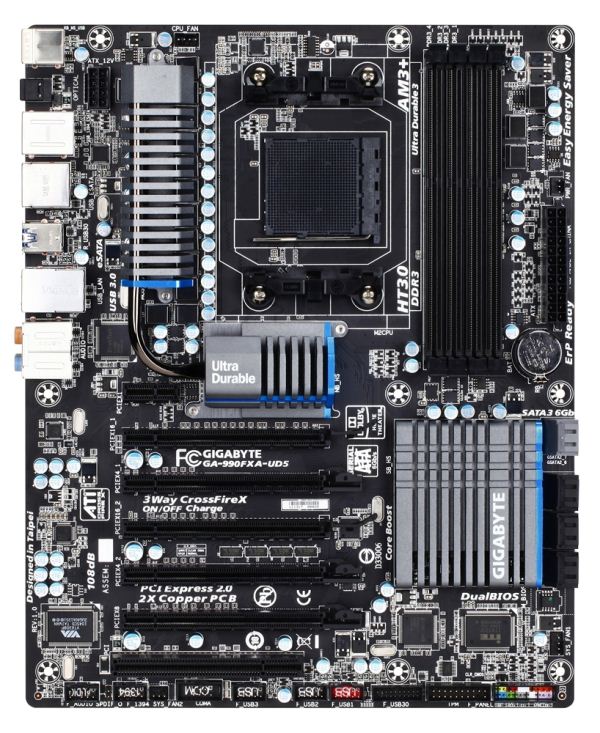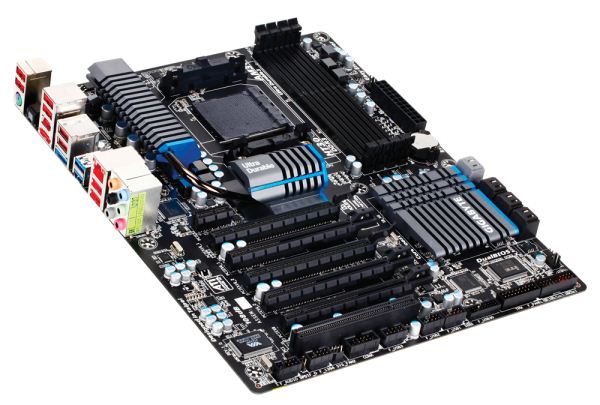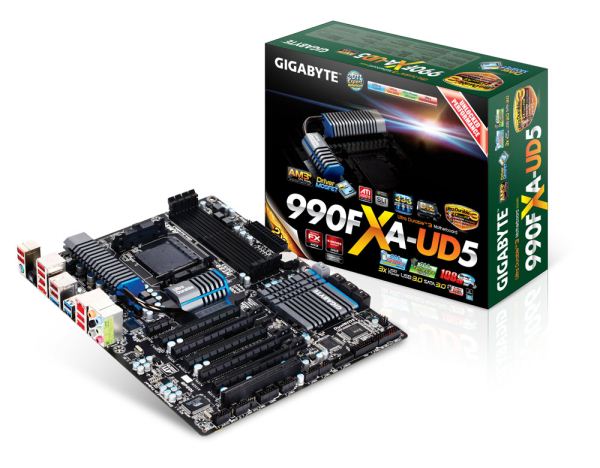990FX Motherboard Roundup with Thuban and Bulldozer – A Second Wind for ASUS, Gigabyte, MSI and Biostar
by Ian Cutress on April 5, 2012 11:00 AM ESTGigabyte 990FXA-UD5
In the land of Gigabyte marketing, we have market segregation. The UD3/4 and below are considered primarily low end with a large dollop of mainstream at the UD3 level, and anything bearing the name UD5 or UD7+ is where their enthusiast section lies. Gamers have the G series, consisting of models named Sniper and Assassin, depending on your needs. Gigabyte also like to come out with one-off products, such as the X58A-OC, a board dedicated for extreme overclocking at sub-zero temperatures, or when pairing Sandy Bridge boards with onboard SSDs to take advantage of caching.
The board we have here representing the 900-series is the 990FXA-UD5, so we are talking for the most part here about the enthusiast end of the market that comes in at a steady price of $180, below both the MSI and the ASUS Sabertooth counterparts. But does it measure up?
Overview
When it comes to selecting an appropriate 990FX board for your AMD processor, a Gigabyte model is going to appear somewhere. At around the $180, the 990FXA-UD5 does come as an option filling a lot of requirements – plenty of PCIe functionality with some extra SATA ports. You miss out on a little bit though, with only basic Realtek Audio/NIC functionality, and the box of goodies is not particularly numerate. The PCIe layout could be a little improved, as to use dual video cards at maximum bandwidth leaves no gap between the GPUs. I would have liked to see power/reset buttons on the board with a debug LED just for testing purposes.
We still have access to the old-school way of presenting a BIOS in blue and white, but this lends itself easily to overclocking the system. There were some minor issues with reading the voltages on Bulldozer processors, resulting in some not-so-stellar overclocks which caused the VRMs to get hot. One of the main issues with the motherboard that may irritate some users is the temperature of the VRMs, which gets obscenely high at serious loads and overclocks. It may have been an idea to beef up the heatsinks or add active cooling in this regard.
Fan controls are not the best in the world as well, but overall the board was easy enough to use. Looking at the notes I wrote while testing the board, the fact that my fan was essentially stopped while at idle is good, but on this revision of the board the CPU voltage ripple under load was of concern. Audio users will want to close EasyTune6, as it causes spikes in DPC Latency which could filter through to the audio.
Visual Inspection
The Gigabyte 990FXA-UD5 does not immediately jump out in terms of looks. The board sports the Gigabyte higher end black PCB and slots, and is combined with silver heatsinks that feel relatively substantial. With the AM3/AM3+ socket being the size that it is, there should not be any trouble installing substantial CPU coolers, though as with previous Gigabyte models, the DRAM slots seem to be further in from the edge of the board compared to other companies designs. This should not have much effect on the overall usage of the board.
Gigabyte has fitted the board with only four fan headers, with the 4-pin CPU fan header located at the top left of the socket. The nearest header to this is the PWR 3-pin on the right side of the board above the 24-pin ATX connector – this is potentially frustrating for users of water cooling who would like to equip two fans to their radiator in a standard location. The other headers are located on the bottom of the board – a 4-pin SYS header is below the SATA ports, and a 3-pin SYS header is in the bottom left below the PCIe slots.
For the heatsink design, the Gigabyte board uses a substantial sized heatsink for the VRMs, which is connected via a heatpipe to another cooler below the socket. The chipset cooler in the bottom right is fairly big and flat, attempting to provide a balance of mass, surface area and cooling efficiency (not to mention advertising space). Below the 24-pin ATX header is the battery, which is a little deviation from almost every other board out there – normally we see it between the PCIe slots, but as there are a lot of full length PCIe slots on the UD5, it makes sense to put the battery out of harm's way.
SATA layout starts with a Marvell 88SE9172 controller offering two SATA 6 Gbps ports (support for RAID 0, 1) in grey, followed by the six SATA 6 Gbps ports from the PCH (support for RAID 0, 1, 5, 10). The Gigabyte board has more SATA 6 Gbps ports (non-eSATA) than any other product tested in this review.
Continuing around the board, below the chipset heatsink we find an EtronTech controller for the onboard USB 3.0 header, next to the Gigabyte standard Trusted Platform Module (TPM) header. I have mentioned in previous reviews that Gigabyte like including this feature of the chipset as it incurs no extra cost and they apparently have enough of a user base who uses the feature. I was told by another manufacturer that a feature is typically included in the board design if around 25% of users would use it, so it would be interesting to hear from Gigabyte regarding take up numbers.
Further along the bottom of the board are the standard array of USB 2.0 headers, a COM header, an IEEE1394 header and front panel audio. Unfortunately, there are no signs of onboard power or reset buttons, or a Clear CMOS button even on the back panel.
It may seem odd to find the front panel audio at the bottom left of the board, when typically the front of the system is on the right – this is due to the audio subsystem being located primarily in the back panel. This Gigabyte board sports a Realtek ALC889 audio solution which is focused to the back panel and then routed to a header. If they were to route to the front of the board and still keep audio quality high, it would need another layer in the PCB (if not two) and would incur extra costs to the consumer.
For PCIe layout we have a single PCIe x1 at the top, but this is blocked for long PCIe x1 cards due to the heatsink. The full length slots underneath are labeled x16, x4, x16, x4, x8, x4, PCI – this layout raises a few issues and questions. For two GPUs to fully utilize x16/x16, they are placed in full slots in position 2 and 4 of the layout – if the GPUs are double slot wide, then this will cause the top GPU to be restricted to the air flow. The third GPU then goes in to position 6 – what would make more sense is to have the second x16 slot in position 6, giving both GPUs room to breathe. I should also mention that when three GPUs are used, the second x16 reduces to an x8.

The back panel is typical of a board at this range. We have eight USB 2.0 ports in red, two USB 3.0 ports in blue, a combination PS/2 port for mice and keyboards, an optical S/PDIF output, IEEE1394 output, one eSATA 3 Gbps in red, one eSATA 3 Gbps in blue, a Realtek 8111E gigabit Ethernet port, and standard audio jacks.













57 Comments
View All Comments
mmstick - Thursday, April 5, 2012 - link
The primary problem with AMD FX is that in order to use the full power of the FPU the program needs to be compiled with FMA4 support, else it is only using half of the FPUs, thus making it a quad core. Secondly, many Windows-based programs are compiled with the Intel C+ compiler, so although the FX may support AVX and many other instructions, the compiled program sees it as a non-Intel CPU so it disables those instruction sets, allowing Intel CPUs to be optimized, and AMD CPUs to remain deoptimized. This is what happens when you are up against someone with the most market share, whom has the ability to dictate what instruction sets they want programmers to use. As well, when people say they are going to buy Intel CPUs instead because they claim AMD didn't make a good processor, why do you think they can't be on top of performance? Without R&D budget there isn't much that can be done, and when you face someone who practically owns a monopoly, that makes it even moreso harder to compete.Omoronovo - Thursday, April 5, 2012 - link
The IC++ compiler has not done that since 2010 when they were forced to settle their antitrust dispute with AMD.DigitalFreak - Thursday, April 5, 2012 - link
" This is what happens when you are up against someone with the most market share, whom has the ability to dictate what instruction sets they want programmers to use. As well, when people say they are going to buy Intel CPUs instead because they claim AMD didn't make a good processor, why do you think they can't be on top of performance? Without R&D budget there isn't much that can be done, and when you face someone who practically owns a monopoly, that makes it even moreso harder to compete."Waaaaah. It's always someone else's fault.
anubis44 - Friday, November 9, 2012 - link
"Waaaaah. It's always someone else's fault."Well, sometimes it really IS someone else's fault. If the mafia had it in for you, and cut your brake cables and burnt your house down when you weren't looking, you'd say it's 'someone else's fault' too. Intel's blackmail and threats to suppliers who used AMD processors kinda screwed AMD over just a tad.
That said, I think now that Jim Keller is back at AMD and head of AMD's CPU division, it won't be too long before AMD is seriously back in the game.
Monkeysweat - Thursday, April 5, 2012 - link
I saw them on some of the benchmarks, why didn't you post them along side the AMD benchies for gaming?If we are looking at a roundup of the best of what AMD and it's partners have to offer, I'd like to see what the competing team brings to the table,, just leave em stock and even let the AMD ones get overclocked.
I wouldn't even worry about cherry picking the Intel combos,, just something random.
Beenthere - Thursday, April 5, 2012 - link
AMD has not abandoned the highend CPU market. Their focus may be broadening but that does not mean they will discontinue discrete highend desktop CPUs for at least several years. Eventually everyone except a small group will use APUs as they will deliver the best performance/value proposition. Only extremists will bother with a discrete CPU/GPU with higher power consumption, increased heat and little practical benefit for mainstream users.Articuno - Thursday, April 5, 2012 - link
It's a pretty nice chipset and the lower tier boards are quite cost-effective. Just wish Bulldozer was competitive with Intel, let alone their last gen chips.Mathieu Bourgie - Thursday, April 5, 2012 - link
Thank you for this article Ian.Are there any chance that we'll see a review of the newer FX-6200 CPU or at least have data for it in the CPU bench? Considering that it's 500MHz faster than the model that it's replacing and no major site (or any that I can see) did a review of it, it'd be interesting to see how it performs.
I'm curious to see if it's a valid alternative, in any way, for $170, vs the Intel Core i5-2300 ($180).
I don't expect any miracle for gaming performance, but for workstation workloads (Photoshop, video editing and the like), who knows?
Thanks,
Mathieu
cosminmcm - Thursday, April 5, 2012 - link
There is a review at pcper, a good one. The processor is pretty weak, nothing exciting there. Thuban walks all over it.Mathieu Bourgie - Friday, April 6, 2012 - link
Thanks, I didn't see that.Quite disappointing indeed.
Here's about that Piledriver or Trinity are more competitive.